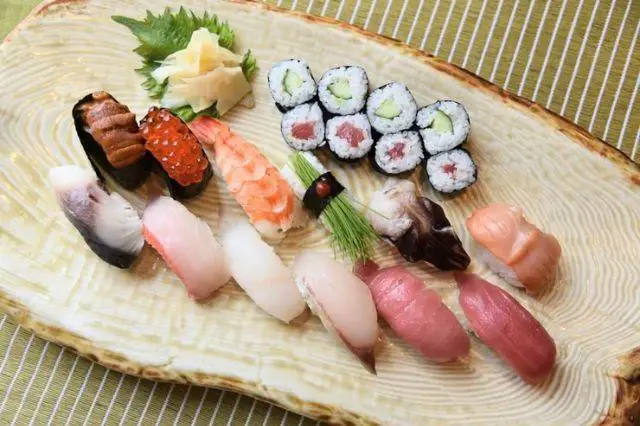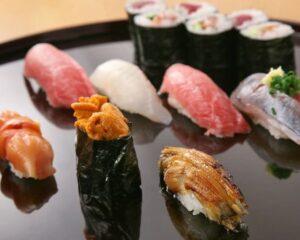🍣 Savoring Sushi in Tokyo: Best Restaurants for Fresh Fish 🇯🇵
Dive into Tokyo's Culinary Delights with the Best Sushi Joints

Introduction
Tokyo, the bustling metropolis of Japan, is often regarded as the sushi capital of the world. Its reputation for serving some of the freshest and most exquisite sushi has attracted sushi enthusiasts and foodies from across the globe. In the heart of Tokyo, where tradition meets innovation, the art of sushi-making is taken to new heights.
Sushi, a beloved culinary art form, relies heavily on the quality and freshness of its key ingredient: fish. In Tokyo, this commitment to procuring the freshest fish is not just a culinary preference; it’s a way of life. In this article, we’ll embark on a delectable journey through Tokyo’s sushi scene, where we’ll explore the best restaurants that offer not only mouthwatering sushi but also an authentic experience steeped in tradition and creativity.
Join us as we delve into the essence of Tokyo sushi, discover hidden gems, and learn how to navigate the sushi culture in this vibrant city. Whether you’re a sushi aficionado or a novice eager to savor this iconic Japanese dish, this guide will help you make the most of your sushi adventure in Tokyo.
The Essence of Tokyo Sushi
1. History and evolution of sushi in Tokyo
Tokyo, the bustling metropolis of Japan, is not only renowned for its skyscrapers and cultural landmarks but also for its exquisite sushi. To truly appreciate the essence of Tokyo sushi, one must delve into its rich history and evolution.
Sushi, as we know it today, has its roots in Tokyo, formerly known as Edo. Edo-style sushi, the precursor to Tokyo sushi, emerged during the Edo period (17th to 19th century). Back then, sushi was a street food, served in small stalls. The rice was fermented for a longer period, imparting a distinct sour taste.
As Tokyo transformed into a thriving city, so did its sushi. The sushi masters in Edo began to experiment with fresher ingredients, including seafood from Tokyo Bay. This shift towards freshness and precision in sushi preparation laid the foundation for the Tokyo-style sushi we savor today.
2. Unique characteristics of Tokyo-style sushi
Tokyo-style sushi stands out for its meticulous craftsmanship and attention to detail. Unlike other regional styles, it emphasizes simplicity, allowing the natural flavors of the ingredients to shine. Here are some unique characteristics that define Tokyo-style sushi:
- Nigiri Perfection: Tokyo sushi is famous for its nigiri, the hand-pressed rice topped with seafood. Each piece is crafted with precision, ensuring the rice is neither too compact nor too loose, providing the perfect balance of textures.
- Seasonal Sensibility: Tokyo sushi chefs prioritize seasonal ingredients, showcasing the freshest catches and produce. This ensures that every bite bursts with flavor and freshness.
- Minimalism: Tokyo-style sushi typically features a minimalist approach to seasoning. Soy sauce and wasabi are used sparingly to enhance, not overpower, the natural flavors of the fish and rice.
- Artistry in Presentation: The presentation of Tokyo sushi is a work of art. Each dish is arranged with precision and attention to color, texture, and balance, creating an aesthetically pleasing culinary experience.
3. Why fresh fish is paramount
Freshness is the lifeblood of Tokyo-style sushi. It’s not just a preference; it’s a fundamental principle. The proximity of Tokyo to the sea plays a pivotal role in ensuring the quality of the fish used in sushi. Here’s why fresh fish is paramount:
- Flavor: Freshly caught fish boasts vibrant flavors and a delightful texture that can’t be replicated by frozen or aged alternatives. This freshness elevates the sushi experience to a new level.
- Safety: Tokyo sushi adheres to strict quality and safety standards. Fresh fish is less prone to harmful bacteria or parasites, ensuring that diners can indulge in their favorite delicacies with confidence.
- Respect for Tradition: Sushi chefs in Tokyo pay homage to tradition by sourcing the finest, freshest ingredients. This commitment to tradition preserves the authenticity of Tokyo-style sushi.

-
Reservation tips
Experiencing the culinary delight of sushi in Tokyo is a sought-after experience, and securing a reservation at a top-notch sushi restaurant can be a bit of a challenge. Here are some tips to help you navigate the reservation process:
- Plan Ahead: Tokyo’s renowned sushi establishments often have limited seating, so plan your visit well in advance. Make reservations at least a few weeks ahead of your intended dining date.
- Hotel Concierge: If you’re staying at a reputable hotel in Tokyo, enlist the help of the concierge. They often have valuable connections and can assist in securing reservations for you.
- Online Reservation Platforms: Some sushi restaurants in Tokyo now offer online reservation systems or have partnerships with reservation platforms. Research and utilize these services for added convenience.
- Flexible Timing: Be open to dining at off-peak hours, such as for lunch or early dinner. You may have an easier time securing a reservation during these times.
- Politeness Matters: When making a reservation, always be polite and respectful. Politeness goes a long way in Japanese culture and can improve your chances of securing a booking.
Check out the beginning of Sushi on Wikipedia!
-
Etiquette for dining at sushi restaurants in Tokyo
Sushi dining in Tokyo comes with its own set of etiquettes, and observing them enhances the experience for both you and the sushi chef. Here are some key etiquette tips:
- Arrive on Time: Punctuality is crucial in Japanese culture. Arrive at the restaurant on time for your reservation to show respect for the chef’s schedule.
- Sit at the Counter: If possible, choose a seat at the sushi counter. It allows you to interact with the chef, observe the preparation, and receive sushi directly from their skilled hands.
- Hands vs. Chopsticks: Sushi can be eaten with either hands or chopsticks. Use your hands for nigiri sushi if you prefer, but use chopsticks for sashimi or other dishes.
- Dip Lightly: When dipping sushi in soy sauce, do so lightly to avoid overwhelming the delicate flavors. Dip the fish side, not the rice.
- No Extra Wasabi: Trust the chef’s judgment regarding wasabi. Sushi chefs in Tokyo often apply the appropriate amount of wasabi, so avoid adding more unless you’re sure it’s needed.
- Avoid Mixing: Don’t mix wasabi into soy sauce; it’s considered impolite. If you want to add wasabi, place a small amount directly on the fish.
-
Understanding the omakase experience
Omakase, a popular dining style in Tokyo sushi restaurants, means “I trust the chef” in Japanese. It’s a culinary journey where the chef selects and serves a series of dishes based on the freshest ingredients and their expertise. Here’s how to understand and appreciate the omakase experience:
- Trust the Chef: When you choose omakase, you’re entrusting the chef with your dining experience. Don’t make special requests; instead, let the chef guide you through their creations.
- Variety: Omakase typically includes a variety of sushi, sashimi, and other dishes. Expect a diverse and exciting range of flavors and textures throughout the meal.
- Seasonal Delights: Omakase menus often feature seasonal ingredients, so you’ll get to taste the freshest offerings of the season.
- Engage with the Chef: Sitting at the counter allows you to engage with the chef. Ask questions, express your preferences, and show appreciation for their craftsmanship.
- Enjoy the Journey: Omakase is not just about the destination but the journey. Savor each dish, appreciate the chef’s artistry, and embrace the culinary adventure.
Tokyo’s Hidden Sushi Gems
→ Lesser-known sushi spots worth exploring
While Tokyo boasts some of the world’s most renowned sushi restaurants, there are hidden gems that offer exceptional experiences without the crowds and high price tags. Here are a few lesser-known sushi spots worth exploring:
- Sushi Yu (すし有): Tucked away in a residential area of Shibuya, Sushi Yu is a cozy, family-run sushi bar known for its warm hospitality and fresh, affordable sushi. It’s an excellent choice for those seeking an authentic experience without breaking the bank.
- Sushi Daiwa: Located in Tsukiji Outer Market, Sushi Daiwa is overshadowed by its famous neighbor, Sushi Dai. However, this unassuming spot serves equally delectable sushi, often with shorter lines. Arrive early to avoid the rush.
- Sushi Bun (すし文): Situated in Roppongi, Sushi Bun offers a modern twist on traditional sushi. Chef Bun’s innovative creations incorporate international flavors and ingredients, making it a unique and exciting dining experience.
- Uoshin (魚真): For a taste of sushi with a local touch, visit Uoshin in the Nakameguro area. This izakaya-style sushi restaurant offers an extensive menu of fresh seafood, sushi, and sake in a casual setting.
- Sushi-ya Kanesaka (すし家 かねさか): This Michelin-starred sushi restaurant in the Nihonbashi district offers an intimate dining experience with exceptional sushi craftsmanship. It’s relatively less known among tourists but is a favorite among Tokyo locals.
→ Local recommendations and insider tips
When exploring Tokyo’s hidden sushi gems, it’s helpful to have local recommendations and insider tips to enhance your dining experience:
- Ask Locals: Strike up conversations with Tokyo residents or consult with hotel staff, as they often have valuable insights into lesser-known sushi spots.
- Weekday Dining: Many hidden gems have shorter lines and more availability on weekdays. Consider dining during non-peak hours for a more relaxed experience.
- Chef’s Recommendations: Trust the chef’s recommendations. In lesser-known sushi spots, chefs take pride in their craft and may offer unique creations not found on the menu.
- Learn Basic Japanese: While not mandatory, learning a few basic Japanese phrases can go a long way in establishing a rapport with the chefs and staff. A simple “Arigatou gozaimasu” (Thank you) goes a long way.
- Respect Local Customs: Be mindful of local customs and etiquettes. Remove your shoes if required, and follow any specific rules regarding seating arrangements or interactions with the chef.
- Cash is King: Some hidden sushi spots may not accept credit cards, so it’s wise to carry enough cash to cover your meal.
- Enjoy the Journey: Part of the charm of discovering hidden gems is the sense of adventure. Embrace the experience, savor the flavors, and relish the fact that you’ve uncovered Tokyo’s secret sushi treasures.
Beyond Sushi: Exploring Tokyo’s Culinary Scene
→ Other Japanese culinary experiences in Tokyo
Tokyo’s culinary scene extends far beyond sushi, offering a diverse range of Japanese gastronomic experiences. Here are some must-try options:
- Tempura: Head to a specialized tempura restaurant for a taste of lightly battered and deep-fried delicacies, from shrimp to seasonal vegetables.
- Izakayas: These Japanese-style pubs offer a casual dining experience, where you can sample a wide array of dishes, including grilled skewers (yakitori), small plates (tapas-style), and an assortment of drinks.
- Ramen: Tokyo boasts some of the best ramen shops in the world. From rich tonkotsu (pork bone broth) to shoyu (soy sauce) and miso-based broths, there’s a ramen style to suit every palate.
- Kaiseki: For a taste of Japanese haute cuisine, indulge in a kaiseki meal. These multi-course feasts showcase the art of seasonal ingredients and precise preparation techniques.
- Okonomiyaki: Often dubbed “Japanese pancakes,” okonomiyaki is a savory, customizable dish made with a batter of flour, eggs, and shredded cabbage, with various toppings and sauces.
→ Food markets and street food options
Tokyo’s food markets and street food stalls are treasure troves of culinary delights. Here are some places and dishes to explore:
- Tsukiji Outer Market: While the inner wholesale market has moved, the outer market remains a food lover’s paradise. Sample fresh seafood, street sushi, and Japanese street snacks.
- Ameya-Yokocho: This bustling market in Ueno offers a vibrant mix of street food, clothing, and electronics. Try takoyaki (octopus balls), yakitori, and more.
- Asakusa Nakamise Street: Located near Senso-ji Temple, this shopping street is famous for its traditional Japanese snacks, including ningyo-yaki (sweet bean-filled cakes) and senbei (rice crackers).
- Harajuku Takeshita Street: A hotspot for trendy fashion, this street also features quirky crepe stands and inventive ice cream shops with unique flavors.
→ Culinary tours and workshops
To deepen your culinary experience in Tokyo, consider joining culinary tours or workshops:
- Sushi-Making Classes: Learn the art of sushi making from expert chefs. You’ll get hands-on experience crafting your own sushi rolls and nigiri.
- Food Tours: Join a guided food tour that takes you through various neighborhoods to sample a wide range of Japanese dishes, from street food to traditional cuisine.
FAQs (Frequently Asked Questions)
- How is Tokyo sushi different from sushi elsewhere?
Tokyo sushi emphasizes the purity of flavors and the quality of ingredients, with an unwavering commitment to tradition. - What is the best time to visit the Tsukiji Fish Market?
Early morning is the ideal time to witness the bustling activity and enjoy the freshest sushi. - Are reservations necessary at high-end sushi restaurants in Tokyo?
Yes, it’s highly recommended to make reservations in advance, as these establishments tend to be in high demand. - Can I find vegetarian sushi options in Tokyo?
While Tokyo is famous for its seafood, you can find vegetarian sushi options at select restaurants. - What’s the etiquette for eating sushi in Tokyo?
When eating sushi, use your hands rather than chopsticks, and savor each piece in one bite. - What’s the significance of soy sauce and wasabi in sushi?
Soy sauce and wasabi enhance the flavors of sushi, but use them sparingly to avoid overpowering the delicate taste of the fish.
Conclusion
Tokyo’s sushi culture is a tapestry of tradition, innovation, and unmatched dedication to the art of sushi-making. As we conclude our exploration of the best sushi restaurants in this dynamic city, we hope you’ve gained a deeper appreciation for the role that fresh fish plays in the world of sushi.
From the renowned sushi temples to the hidden gems tucked away in Tokyo’s alleys, this city offers an unparalleled sushi experience that will leave your taste buds dancing with delight. As you prepare to embark on your own sushi journey in Tokyo, remember to savor not just the flavors but also the rich history and culture that accompany each bite.
So, whether you’re indulging in a world-class omakase meal or sampling street food at a local market, Tokyo’s sushi scene promises to be a memorable and savory adventure. Don’t miss the opportunity to explore the city’s other culinary treasures and immerse yourself in the diverse gastronomic wonders of Tokyo. As you depart this bustling metropolis, may your taste buds be forever enchanted by the exquisite flavors of Tokyo’s sushi.
Up Next
🍽️ Exploring the Culinary Delights of Paris: A Guide to French Cuisine 🇫🇷





Facebook Comments